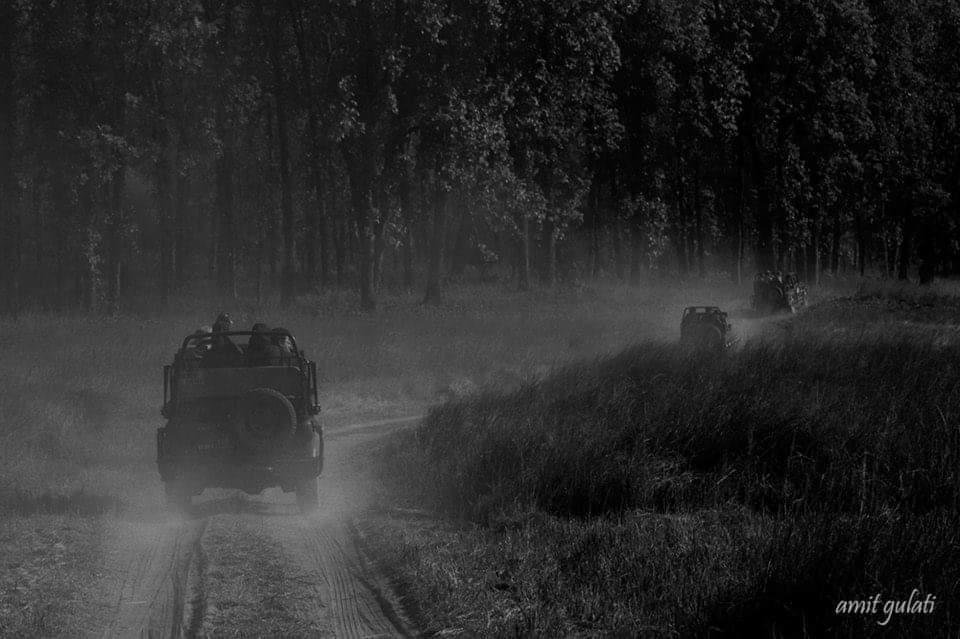| Destination: Bandhavgarh |
| Destination Type: Wildlife |
| City: Bandhavgarh |
| Country: India |
- By Air: The nearest airports are the Khajuraho Civil Aerodrome (250 km) and the Jabalpur Airport (190 km). Both are well connected to major cities like Delhi, Indore, Hyderabad and Mumbai.
- By Rail : The closest railway stations are Umaria (37 km), Katni (100 km), Jabalpur (190 km) and Khajuraho (250 km). These stations are well connected to major cities
- By Road: You can get to Bandhavgarh by state/private transport buses or by car/taxi from Umaria (37 km), Jabalpur (190 km), Katni (100 km) or Khajuraho (250 km).
This is a small National Park; compact, yet full of game. The density of the Tiger population at Bandhavgarh is the highest known in India.
This is also White Tiger country. These have been found in the old state of Rewa for many years. The last known was captured by Maharajah Martand Singh in 1951. This White Tiger, Mohan, is now stuffed and on display in the palace of the Maharajahs of Rewa.
Prior to becoming a National park, the forest around Bandhavgarh had long been maintained as a Shikargah, or game preserve, of the Maharajahs of Rewa. Hunting was carried out by the Maharajahs and their guests - otherwise the wildlife was relatively well-protected.
Bandhavgarh is a place of mythological and legendary significance. The ancient Bandhavgarh Fort is of great importance as it is believed to have been gifted by Lord Rama to his younger brother Lakshmana. 'Bandhav' in English means brother and ‘Garh’ means fort. Hence the name, Bandhavgarh. Bandhavgarh dates back to 2000 years ago and you will find several man made caves with inscriptions and rock paintings.
Bandhavgarh is also the land of tigers. This is the place to visit if you want to spot the big cat. India’s top dwelling for tigers, Bandhavgarh National Park has the highest density of Royal Bengal tigers in the world. The sight of the majestic tiger, up close and personal, is said to trigger a sense of awe in you, of the kinds you would have only experienced in your childhood.
- Shesh Shaiya : Shesh Shaiya is a 65 foot long idol of Lord Vishnu placed horizontally on a seven-headed serpent,located at the originating point of the River Charan Ganga.
- Bandhavgarh National Park : Known for the highest density of tigers in the world,Bandhavgarh National Park is also an abode for wild animals like the Indian bison,Chital,nilgais,chausingha,chinkara,wild boars & Jackals.The park is also home to 250 species of birds like browed fantail,green pigeons and gray Malabar hornbills.
- Bandhavgarh Fort : No records remain to show when Bandhavgarh Fort was constructed. It is thought, however, to be some 2,000 years old, and there are references to it in the ancient books, the Narad-Panch Ratra and the Siva Purana. Various dynasties have ruled this fort: for example, the Maghas from the 1st century AD, the Vakatakas from the 3rd century; the Sengars from the 5th century and the Kalchuris from the 10th century. In the 13th century AD, the Baghels took over, ruling from Bandhavgarh until 1617, when Maharajah Vikramaditya Singh moved his capital to Rewa. The last inhabitants deserted the fort in 1935.
- Badi Gufa : One of the biggest caves in the Bandhavgarh National Park,Badi Gufa dates back to the 10th Century.Carved out of solid sandstone rock,these caves served as sgelter for the army of the king during the medieval period.
- Three Cave Point ; The Three Cave Point is one of the most mesmerizing spots in the Bandhavgarh National Park.This beautiful point has magnificent carbing and is home to leopards,tigers and sloth bears,
- Jwalamukhi Temple : Dedicated to Goddess Jwalamukhi,this temple dates back to the 10th Century and is situated on the bank of river Charan Ganga.
- The Flora & Fauna : The forest of Bandhavgarh can be classified as moist deciduous, and the National Park holds all those animal species which are typical of this habitat in Central India. Certain areas of the park (particularly the south and the west) are drier in character, and hold such species as the Nilgai and the Chinkara.Sal forest occurs throughout the valleys, giving way to mixed forest which occurs where the soil is of relatively poor quality on the upper hill slopes, on rocky outcrops and in the South and West. Grassy meadow patches occur in the valley and along the nalas.
• Visit Wildlife
Things to Do in Bandhavgarh :
Wildlife Experience in Jeep Safari
Spot the Tigers at Chakradhar
Relish a Stay Around Bandhavgarh for a Thrilling Experience
Shopping in Bandhavgarh Market
Trek to Bandhavgarh Fort
Nearby Attractions to Bandhavgarh :
Bandhavgarh fort (permission needed). Since Bandhavgarh is further ahead to Kanha & Penchyou can choose to visit the attractions near
Pench & Kanha.

